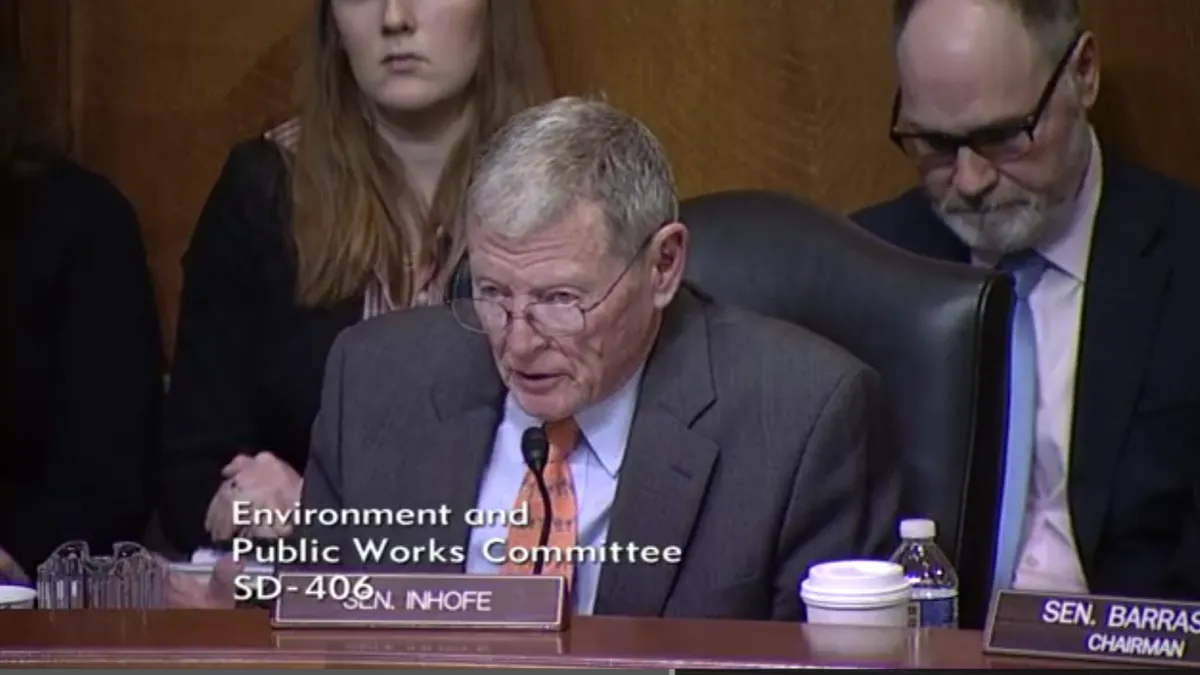Dive Brief:
- Sen. Jim Inhofe, R-Okla., became a co-sponsor on Wednesday of a carbon capture infrastructure bill that has wide bipartisan support, based on the potential of the technology to support coal and gas-fired generation in a carbon constrained regulatory environment.
- The Utilizing Significant Emissions with Innovative Technologies (USE IT) Act, reintroduced Feb. 7 as S. 383, passed the Senate Environment and Public Works (EPW) Committee by voice vote last year, and committee support appears even stronger this time around.
- The latest bill has doubled the number of co-sponsors from the original version last year, including Inhofe and EPW Ranking Member Tom Carper, Del., to 12 senators. Chairman John Barrasso, Wyo., secured a fourth Democratic EPW committee member during the hearing, asking Sen. Chris Van Hollen, Md., to co-sponsor the bill.
Dive Insight:
Inhofe, who threw a snowball on the Senate floor in February 2015 to assert that global warming is a hoax, is a strong supporter of coal generation. While Inhofe opposes decarbonization efforts, such as the Green New Deal proposal, he supports the USE IT Act for its potential to help coal plants meet future stricter emissions standards.
The USE IT Act, which would build out infrastructure to foster economies of scale among carbon capture projects and promote research in carbon technologies such as direct air capture, is enjoying bipartisan support across a broad political spectrum.
Barrasso, who wrote a New York Times editorial last December about the need for climate innovation solutions, identified carbon capture as one of the major areas for bipartisan collaboration.
"Nuclear energy as well as what we are trying to do with the carbon capture sequestration utilization ... are actual, practical, workable solutions that make a difference in climate change and in carbon dioxide [emissions reductions]," Barrasso told reporters.
The USE IT hearing was "the first official recognition that you have to have fossil fuels to run the machine called America," Inhofe told reporters after the hearing. He said he waited until Wednesday to issue his support of the bill so as not to "chase off" any other senators that didn't view the bill that way.
Carbon capture technology paired with coal-fired or other fossil fuel-based generation could curb carbon dioxide emissions, although the technology continues to be prohibitively expensive.
"We're past the science now. We recognize that we're in a carbon constrained world and how do we get there? ... We need time and we need some flexibility," Paul Sukut, CEO and general manager of Basin Electric Power Cooperative, told senators. "My sense is that the USE IT act gives us sort of the roadmap to get there," he said, adding that the federal tax credits approved last year for carbon capture utilization and sequestration (CCUS) projects provide a financial incentive.
However, the 45Q tax credits meant to boost CCUS deployment "do not appear large enough to encourage substantial market penetration" in the U.S. power sector, according to the Energy Information Administration's annual energy outlook, released in January. One solution offered by carbon capture advocates to make the investment worthwhile among generators is to put a price on carbon.
"A carbon price would level the playing field for low-carbon technologies and release a wave of technological innovation," Sen. Sheldon Whitehouse, D-R.I., one of the main co-sponsors of the USE IT Act, told Utility Dive. "While working toward a carbon price, I will continue to find common ground with my Republican colleagues to advance bipartisan climate policies like the USE IT Act. With the scale of the climate issue we're facing, we can't afford to take any solutions off the table.”
The USE IT Act pairs buildout of pipeline infrastructure to store or use carbon dioxide with research and development for other carbon capture technologies, such as direct air capture, which require more support and funding, Steve Oldham, CEO of Carbon Engineering, said.
"We hope your act brings more people to the table," Oldham told senators, noting the lack of researchers and engineers focused on direct air capture. "The funding that you put aside will as I said earlier bring more brilliant minds into this business and that is essential."
By investing in direct air capture, companies in industries that are difficult to directly decarbonize can work toward offsetting their emissions, he said. While existing direct air capture or carbon capture technology works, additional research could help increase efficiencies and lower the cost, Oldham said.
This is not air de-regulation
Ranking Member Carper asked the panel if the Clean Air Act was inhibiting progress of carbon capture utilization and sequestration technology.
"We don't see any impediment by the way programs such as the New Source Review could be applied" when carbon capture equipment would be installed in the power sector, Kurt Waltzer, managing director of the Clean Air Task Force, told the EPW Committee, based on the environmental group's technical and legal perspective.
Barrasso, the lead sponsor on the bill, committed to not use this bill "as a vehicle to weaken the Clean Air Act" and accepted "a number of changes" to last year's legislation, Carper said.
The Environmental Protection Agency proposed changes to regulations on pollution limits for new or modified power plants that questioned whether new plants should be subject to any pollution limits under the Clean Air Act, according to the Environmental Defense Fund.
"I want to ensure that this legislation doesn't lead to other efforts to weaken the Clean Air Act," Carper said.














